new posts in all blogs
Viewing Blog: wild ink, Most Recent at Top
Results 1 - 25 of 80
musings about nature, art, books and writing . . .
Statistics for wild ink
Number of Readers that added this blog to their MyJacketFlap: 1
My new book is out! The teenage characters in Siege dodge ghosts and smugglers during a War of 1812 re-enactment summer camp at Old Fort Erie, Ontario. For several months in the real War of 1812 (which actually ended in 1815), Fort Erie was occupied by US soldiers. One of the biggest and deadliest battles of the war occurred there in August 2014. (Siege is a short easy-to-read novel in the Orca Currents series for 10-14). (Review)




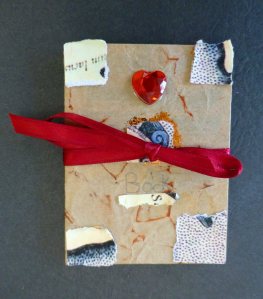
Last spring I did some accordion book-making with kids as part of a writing workshop I taught at the Kamloops Young Authors Conference. We talked about how each story is a “hero’s journey” (with a quest and obstacles to overcome along the journey), then we created accordion book plot diagrams (with participants plotting out their own hero’s journeys). The books are also meant to look old and mysterious ─part treasure map and part talisman. The kids’ books turned out great!
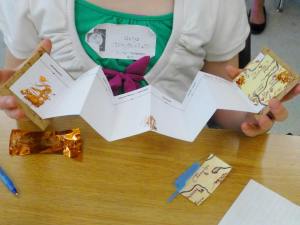
Before the workshop, I set out my supplies to photograph the directions for making a simple accordion book. Of course, the first picture was photo-bombed by my cat (aptly named Curious, she always has to check out everything).
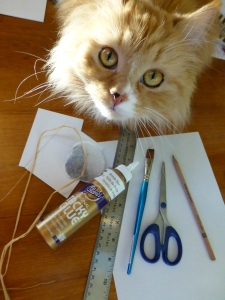
Accordion book supplies:
- two rectangle pieces of cardboard for book covers (cardboard from cereal boxes works well). (For the “Hero’s Journey” book project, I cut the cardboard 2 1/2 inches x 3 1/2 inches).
- two rectangle pieces of decorative paper for book covers (the pieces should be larger than the cardboard by about 1/4 inch or so all around). (For the “Hero’s Journey” book project, I cut the cover paper to 3 1/2 x 4 1/2 inches and used kraft packing paper, which I “aged” by crumpling up the paper, then smoothing it out and adding brown ink & tea bag staining).
- a strip of paper that will be accordion folded to make the book “pages.” When folded, the pages should be slightly smaller than the book covers (for the “Hero’s Journey project, I cut the paper strip 3 x 16 inches, which fit nicely inside the book covers when accordion folded into 2 x 3 sections –also, three of these strips could be cut from a 11 x 17 sheet of paper).
- ribbon or raffia string (my first thought was to use the natural coloured raffia for an antique look, but my cat tried to eat it, so I switched to fabric ribbon). The ribbon should be long enough to wrap around the finished book and tie (I used a 16 inch piece for the “Hero’s Journey” book).
- scissors, glue
- optional: tea bag & brown ink stamp pad for “aging” the covers and inside pages, small pieces of decorative paper to glue inside the covers (we used antique map images for this project), craft jewels & collage items for decorating the covers
Directions (the following photos are from a different accordion book project, using Japanese paper):
1. Once your two pieces of cardboard and two cover papers are cut, place your first piece of cardboard on top of the back of a piece of cover paper (ie on top the side you don’t want showing). Centre it, so that there is an equal overlap of paper around the cardboard.
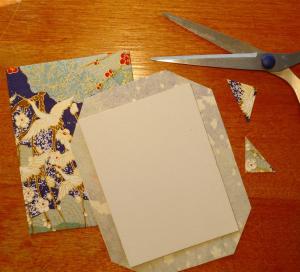

2. Cut the corners off the cover paper at the corners of the cardboard.
3. Fold the edges of the cover paper, so that they wrap tightly over the sides of the cardboard. Glue. (Do this with both covers).
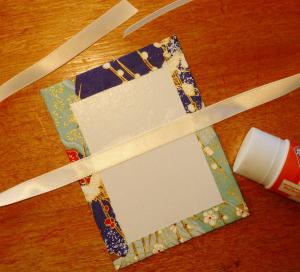
4. Glue ribbon to centre of inside back cover (with equal amount of ribbon on either side).
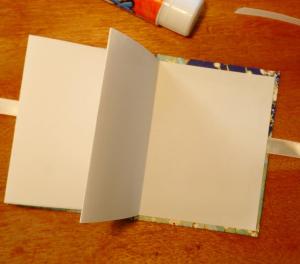
5. Fold long strip of paper in accordion fashion, so that it divides into equal rectangles sized slightly smaller than the covers. Glue end rectangle “page” of accordion folded strip onto centre of back cover (over the ribbon). Glue the first rectangle page over the inside of the remaining cover, so that when the accordion folds are folded together, the covers come together.
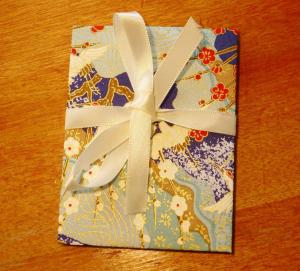
6. wrap the ribbon around the front of the book and tie a bow.


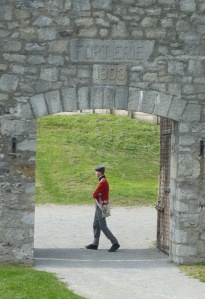 Two hundred years ago, in July 1814, American troops attacked Fort Erie (in what was then British Upper Canada). The British surrendered with only a few shots fired (the fort’s commander was later court-martialled for giving up too easily). The British withdrew from the fort, but made plans to get the fort back. In early August, they set up camp outside the fort, just out of reach of the fort’s guns.
Two hundred years ago, in July 1814, American troops attacked Fort Erie (in what was then British Upper Canada). The British surrendered with only a few shots fired (the fort’s commander was later court-martialled for giving up too easily). The British withdrew from the fort, but made plans to get the fort back. In early August, they set up camp outside the fort, just out of reach of the fort’s guns.
After dark, on August 15, 1814, about 2,400 British soldiers, Canadian militia and First Nations allies attacked. Under the cover of darkness and the heavy gun smoke that hung over the surrounding field, the British stormed the walls of the fort and captured the northeast bastion. Within the fort, the Americans turned a cannon around and fired at the British on top the bastion. The British turned one of the captured cannons and fired back. As this close-range cannon battle raged, a spark found its way to the powder magazine under the bastion. The explosion killed 400 men (mostly British and Canadians) and turned the tide of the battle in favour of the Americans.
The British retreated from the fort (with almost the entire column that had attacked the bastion, wiped out), but continued their siege for days. By the time the siege ended on September 17, 3,500 men were killed, wounded, or missing. It was the most devastating and prolonged battle of the war.
Today, Old Fort Erie is a museum, which I visited last fall to research the setting of my new novel Siege (for readers approx. ages 10-14), which will be out October 1. This coming weekend (August 9-10, 2014) hundreds of re-enactors from both Canada and the U.S. will be gathering at the fort to commemorate the 200-year anniversary of the siege. It promises to be the largest War of 1812 re-enactment in Canada. Unfortunately, I won’t be at the re-enactment, but I’ll be imagining the characters of my novel on top the fort’s walls in the middle of the musket and cannon smoke.
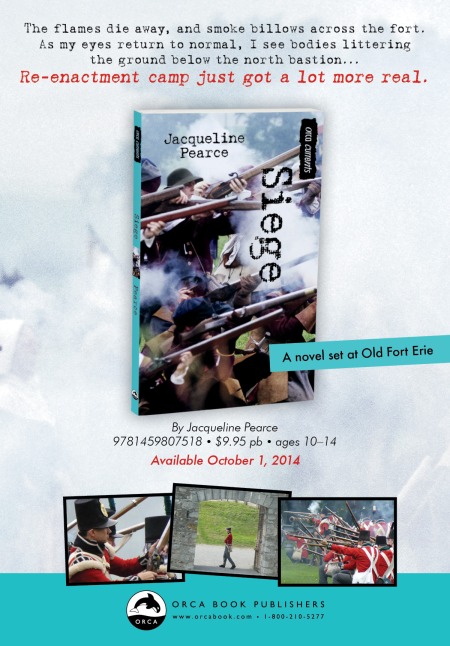


 Two hundred years ago, in July 1814, American troops attacked Fort Erie (in what was then British Upper Canada). The British surrendered with only a few shots fired (the fort’s commander was later court-martialled for giving up too easily). The British withdrew from the fort, but made plans to get the fort back. In early August, they set up camp outside the fort, just out of reach of the fort’s guns.
Two hundred years ago, in July 1814, American troops attacked Fort Erie (in what was then British Upper Canada). The British surrendered with only a few shots fired (the fort’s commander was later court-martialled for giving up too easily). The British withdrew from the fort, but made plans to get the fort back. In early August, they set up camp outside the fort, just out of reach of the fort’s guns.
After dark, on August 15, 1814, about 2,400 British soldiers, Canadian militia and First Nations allies attacked. Under the cover of darkness and the heavy gun smoke that hung over the surrounding field, the British stormed the walls of the fort and captured the northeast bastion. Within the fort, the Americans turned a cannon around and fired at the British on top the bastion. The British turned one of the captured cannons and fired back. As this close-range cannon battle raged, a spark found its way to the powder magazine under the bastion. The explosion killed 400 men (mostly British and Canadians) and turned the tide of the battle in favour of the Americans.
The British retreated from the fort (with almost the entire column that had attacked the bastion, wiped out), but continued their siege for days. By the time the siege ended on September 17, 3,500 men were killed, wounded, or missing. It was the most devastating and prolonged battle of the war.
Today, Old Fort Erie is a museum, which I visited last fall to research the setting of my new novel Siege (for readers approx. ages 10-14), which will be out October 1. This coming weekend (August 9-10, 2014) hundreds of re-enactors from both Canada and the U.S. will be gathering at the fort to commemorate the 200-year anniversary of the siege. It promises to be the largest War of 1812 re-enactment in Canada. Unfortunately, I won’t be at the re-enactment, but I’ll be imagining the characters of my novel on top the fort’s walls in the middle of the musket and cannon smoke.



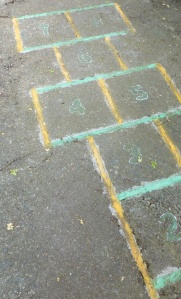 I’ve been “tagged” by author friend Laura Langston to join in a game of blog hop. The rules of the game: answer four questions about your writing and writing process, and tag three more people. Laura writes picture books, young adult novels and adult novels. To see her post on the blog hop, click here.
I’ve been “tagged” by author friend Laura Langston to join in a game of blog hop. The rules of the game: answer four questions about your writing and writing process, and tag three more people. Laura writes picture books, young adult novels and adult novels. To see her post on the blog hop, click here.
Here I go with the questions:
1) What am I working on?
I’ve just finished the final edits for a new novel called Siege (for ages 10-14), which will be out this fall with Orca Books. It’s about a teenage boy who reluctantly attends a War of 1812 re-enactment summer camp and discovers some modern-day criminal activity around the Niagara River and Old Fort Erie. As part of my research for the story, I watched the re-enactment of the Battle of Queenston Heights on its 200-year anniversary and also visited Old Fort Erie. I have a picture book story about the War of 1812 in the works as well.
I’m also working on two short non-fiction stories about dogs which will appear in Chicken Soup for the Soul: The Dog Did What?, scheduled for release in August.
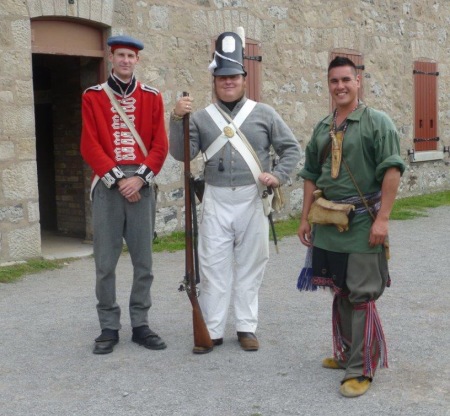
Re-enactor staff at Fort Erie answered my many questions while I poked around the fort
2) How does my work differ from others of its genre?
My newest book, Siege, mixes history in with the present day, which is a bit unusual. I don’t think I’ve come across any other stories about people re-enacting historical events. It was fun to write, partly because the main character doesn’t want to be where he is, and I enjoyed writing about his reactions to things like his musket misfiring, the old fort’s ghost stories, and trying to navigate the Niagara River in an old-fashioned row boat.
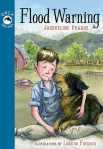 I’ve also written more straight-forward contemporary fiction and historical fiction. Flood Warning, for example, is a chapter book (for ages 6-8) that takes place during the Fraser River flood of 1948. There aren’t a lot of chapter books that tell historical stories (especially BC and Canadian history), which makes my story (and the others I’d like to write) somewhat unique.
I’ve also written more straight-forward contemporary fiction and historical fiction. Flood Warning, for example, is a chapter book (for ages 6-8) that takes place during the Fraser River flood of 1948. There aren’t a lot of chapter books that tell historical stories (especially BC and Canadian history), which makes my story (and the others I’d like to write) somewhat unique.
3) Why do I write what I do?
I write for kids because it’s something I’ve wanted to do ever since I was a kid (about the time my dad made the hopscotch in our backyard, which appears at the top of this post). I fell in love with books such as The Narnia Chronicles by C.S. Lewis and the Emily of New Moon series by Lucy Maud Montgomery when I was in grade six and have continued to love books for children (both reading them and writing them). I also sometimes write poetry and nonfiction for adults, but writing for kids is my main compulsion.
As for what I write about: I like to explore the world around me and notice things that maybe nobody else is paying attention to. I’m always fascinated by history, nature, and unique bits and pieces that I stumble across. When something surprises or intrigues me, I immediately start imagining it as part of a story (I always keep a notebook handy). I write about things that interest me and hope someone else will be interested, too.
4) How does my writing process work?
Usually when I’m working on a new story, I do quite a bit of research first (which I always enjoy, especially when it involves visiting interesting new places or trying out some new activity). Sometimes I find it difficult to actually sit down and begin the writing, though, and I might procrastinate by doing more research, or even by doing some different types of writing (like nonfiction articles or blog posts). But, once I dig into a story, it starts to flow, and I get caught up in the world of the story.
I do most of my writing from my home office. If I need a break, or get stuck on some aspect of the story, I go for a walk, and usually the problem or the next scene works itself out in my mind as I walk. Rather than doing several drafts of a story, I edit as I go, which means sometimes I can rework the same chapter or scene for days before moving on, and by the time I get to the end of the first draft of the story, it’s fairly polished. But, of course, there’s always more editing to be done.

sunset from my office window
For the next stop on the blog hop, I’ve tagged Cindy Henrichs and Daniela Elza (I tried to tag a third person, but everyone else got away), and they’ll be blogging on June 16.
Cynthia Heinrichs is the author of two books: Mermaids, a picture book about the diving women of South Korea, and Under the Mound, a novel for young adults set in 12th-century Scotland. Cynthia is also a regular contributor to British Columbia Magazine. She lives in Vancouver, BC, where she writes and tutors college students in academic writing. To learn more about Cynthia, please visit her website here (and check out her blog on June 16).
Daniela Elza had been published nationally and internationally in over 80 publications. Her poetry books are milk tooth bane bone (Leaf Press, 2013), the weight of dew (Mother Tongue Publishing, 2012) and the book of It (2011). Daniela earned her doctorate in Philosophy of Education from Simon Fraser University and was the 2014 Writer-In-Residence at the University of the Fraser Valley. Check out her website here (her blog hop post will be up June 16).
Note: If the next blog hop posts aren’t up by June 16, please check again in a few days.
Thanks for playing!


 I’ve been “tagged” by author friend Laura Langston to join in a game of blog hop. The rules of the game: answer four questions about your writing and writing process, and tag three more people. Laura writes picture books, young adult novels and adult novels. To see her post on the blog hop, click here.
I’ve been “tagged” by author friend Laura Langston to join in a game of blog hop. The rules of the game: answer four questions about your writing and writing process, and tag three more people. Laura writes picture books, young adult novels and adult novels. To see her post on the blog hop, click here.
Here I go with the questions:
1) What am I working on?
I’ve just finished the final edits for a new novel called Siege (for ages 10-14), which will be out this fall with Orca Books. It’s about a teenage boy who reluctantly attends a War of 1812 re-enactment summer camp and discovers some modern-day criminal activity around the Niagara River and Old Fort Erie. As part of my research for the story, I watched the re-enactment of the Battle of Queenston Heights on its 200-year anniversary and also visited Old Fort Erie. I have a picture book story about the War of 1812 in the works as well.
I’m also working on two short non-fiction stories about dogs which will appear in Chicken Soup for the Soul: The Dog Did What?, scheduled for release in August.

Re-enactor staff at Fort Erie answered my many questions while I poked around the fort
2) How does my work differ from others of its genre?
My newest book, Siege, mixes history in with the present day, which is a bit unusual. I don’t think I’ve come across any other stories about people re-enacting historical events. It was fun to write, partly because the main character doesn’t want to be where he is, and I enjoyed writing about his reactions to things like his musket misfiring, the old fort’s ghost stories, and trying to navigate the Niagara River in an old-fashioned row boat.
 I’ve also written more straight-forward contemporary fiction and historical fiction. Flood Warning, for example, is a chapter book (for ages 6-8) that takes place during the Fraser River flood of 1948. There aren’t a lot of chapter books that tell historical stories (especially BC and Canadian history), which makes my story (and the others I’d like to write) somewhat unique.
I’ve also written more straight-forward contemporary fiction and historical fiction. Flood Warning, for example, is a chapter book (for ages 6-8) that takes place during the Fraser River flood of 1948. There aren’t a lot of chapter books that tell historical stories (especially BC and Canadian history), which makes my story (and the others I’d like to write) somewhat unique.
3) Why do I write what I do?
I write for kids because it’s something I’ve wanted to do ever since I was a kid (about the time my dad made the hopscotch in our backyard, which appears at the top of this post). I fell in love with books such as The Narnia Chronicles by C.S. Lewis and the Emily of New Moon series by Lucy Maud Montgomery when I was in grade six and have continued to love books for children (both reading them and writing them). I also sometimes write poetry and nonfiction for adults, but writing for kids is my main compulsion.
As for what I write about: I like to explore the world around me and notice things that maybe nobody else is paying attention to. I’m always fascinated by history, nature, and unique bits and pieces that I stumble across. When something surprises or intrigues me, I immediately start imagining it as part of a story (I always keep a notebook handy). I write about things that interest me and hope someone else will be interested, too.
4) How does my writing process work?
Usually when I’m working on a new story, I do quite a bit of research first (which I always enjoy, especially when it involves visiting interesting new places or trying out some new activity). Sometimes I find it difficult to actually sit down and begin the writing, though, and I might procrastinate by doing more research, or even by doing some different types of writing (like nonfiction articles or blog posts). But, once I dig into a story, it starts to flow, and I get caught up in the world of the story.
I do most of my writing from my home office. If I need a break, or get stuck on some aspect of the story, I go for a walk, and usually the problem or the next scene works itself out in my mind as I walk. Rather than doing several drafts of a story, I edit as I go, which means sometimes I can rework the same chapter or scene for days before moving on, and by the time I get to the end of the first draft of the story, it’s fairly polished. But, of course, there’s always more editing to be done.

sunset from my office window
For the next stop on the blog hop, I’ve tagged Cindy Henrichs and Daniela Elza (I tried to tag a third person, but everyone else got away), and they’ll be blogging on June 16.
Cynthia Heinrichs is the author of two books: Mermaids, a picture book about the diving women of South Korea, and Under the Mound, a novel for young adults set in 12th-century Scotland. Cynthia is also a regular contributor to British Columbia Magazine. She lives in Vancouver, BC, where she writes and tutors college students in academic writing. To learn more about Cynthia, please visit her website here (and check out her blog on June 16).
Daniela Elza had been published nationally and internationally in over 80 publications. Her poetry books are milk tooth bane bone (Leaf Press, 2013), the weight of dew (Mother Tongue Publishing, 2012) and the book of It (2011). Daniela earned her doctorate in Philosophy of Education from Simon Fraser University and was the 2014 Writer-In-Residence at the University of the Fraser Valley. Check out her website here (her blog hop post will be up June 16).
Note: If the next blog hop posts aren’t up by June 16, please check again in a few days.
Thanks for playing!


 I didn’t expect to see much in Vancouver’s Dr. Sun Yat-Sen Garden in the middle of January, but when I visited last Saturday, I found it blooming with red lanterns and bustling with preparations for Chinese New Year. I was also surprised to see winter jasmine in flower and many trees full of early buds.
I didn’t expect to see much in Vancouver’s Dr. Sun Yat-Sen Garden in the middle of January, but when I visited last Saturday, I found it blooming with red lanterns and bustling with preparations for Chinese New Year. I was also surprised to see winter jasmine in flower and many trees full of early buds.
The Chinese lunar New Year (which begins on January 31 this year) is a time for sweeping away the old (dust, clutter, debts, worries) and welcoming in the new (renewing hope for health, happiness, and good fortune). Staff and volunteers at the garden were busy cleaning, tidying, tying up loose-ends, and decorating in preparation for the upcoming Year of the Horse Temple Fair, Feb 2 (2014). Red lanterns are hung around the garden to bring good luck (red is considered the most auspicious colour because of its association with fire, the sun, energy, light, and life-blood, which demons fear, so it also keeps demons away), and they welcome back the light of spring.
A few images and haiku from my visit:
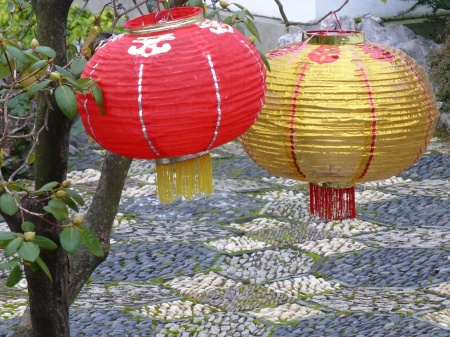
New Year’s lanterns─
the courtyard mosaics
swept clear
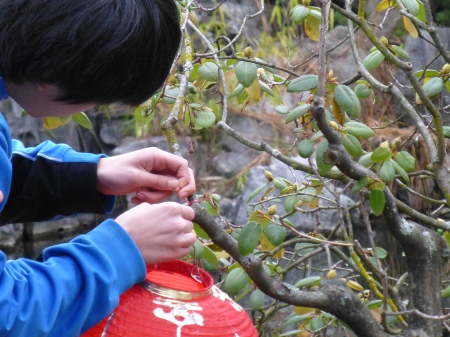
preparing for
the New Year─
peony buds
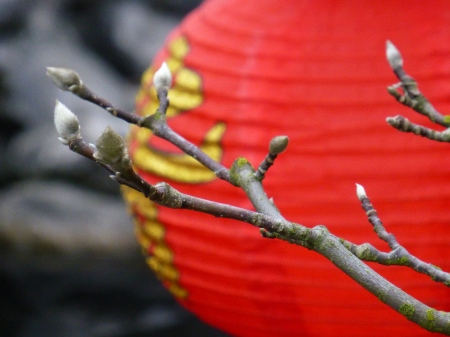
still pond─
finding the courage
to say goodbye
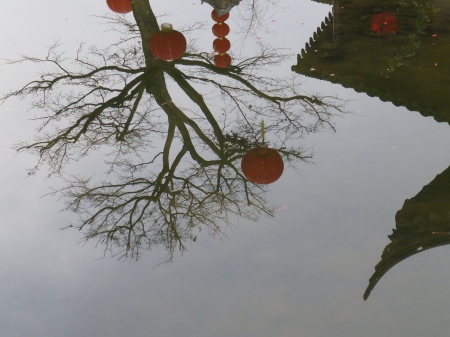
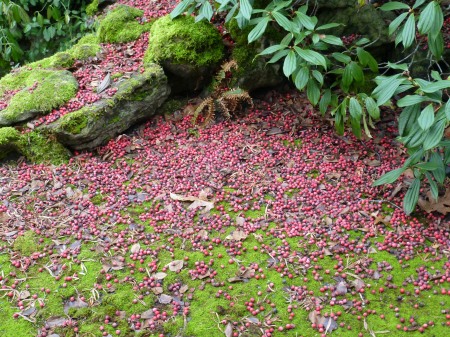
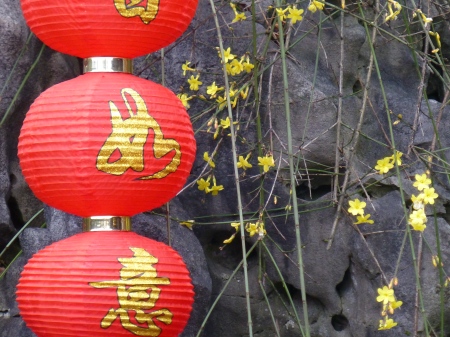
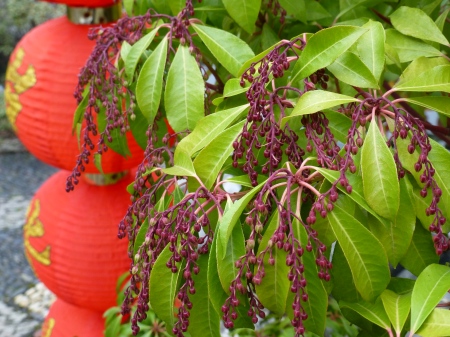



 I didn’t expect to see much in Vancouver’s Dr. Sun Yat-Sen Garden in the middle of January, but when I visited last Saturday, I found it blooming with red lanterns and bustling with preparations for Chinese New Year. I was also surprised to see winter jasmine in flower and many trees full of early buds.
I didn’t expect to see much in Vancouver’s Dr. Sun Yat-Sen Garden in the middle of January, but when I visited last Saturday, I found it blooming with red lanterns and bustling with preparations for Chinese New Year. I was also surprised to see winter jasmine in flower and many trees full of early buds.
The Chinese lunar New Year (which begins on January 31 this year) is a time for sweeping away the old (dust, clutter, debts, worries) and welcoming in the new (renewing hope for health, happiness, and good fortune). Staff and volunteers at the garden were busy cleaning, tidying, tying up loose-ends, and decorating in preparation for the upcoming Year of the Horse Temple Fair, Feb 2 (2014). Red lanterns are hung around the garden to bring good luck (red is considered the most auspicious colour because of its association with fire, the sun, energy, light, and life-blood, which demons fear, so it also keeps demons away), and they welcome back the light of spring.
A few images and haiku from my visit:

New Year’s lanterns─
the courtyard mosaics
swept clear

preparing for
the New Year─
peony buds

still pond─
finding the courage
to say goodbye







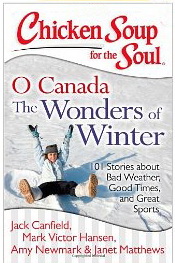 Everywhere it snows, kids love winter. The first snow of the year is always the most exciting ─especially if you live in a place like the south-west coast of British Columbia, where snow is not guaranteed. When my boyfriend and I moved from Vancouver Island to Toronto to go to university, we were looking forward to escaping the cool, rainy winds of Victoria and experiencing a real Canadian winter of sunshine sparkling on snow and ice hockey on frozen ponds. We packed all our essential possessions in two large hockey bags (including two pairs of skates and a toaster oven). The morning we left, we discovered that our friends had graffitied a sarcastic message on the road in front of my boyfriend’s house: Craig loves Harold Ballard (Harold Ballard was the coach of the Toronto Maple Leafs hockey team at that time, and my boyfriend was not a Leaf’s fan). [Note: scrawled on the road in front of my parents' house were the words There is no pie in Toronto, but that's another story.]
Everywhere it snows, kids love winter. The first snow of the year is always the most exciting ─especially if you live in a place like the south-west coast of British Columbia, where snow is not guaranteed. When my boyfriend and I moved from Vancouver Island to Toronto to go to university, we were looking forward to escaping the cool, rainy winds of Victoria and experiencing a real Canadian winter of sunshine sparkling on snow and ice hockey on frozen ponds. We packed all our essential possessions in two large hockey bags (including two pairs of skates and a toaster oven). The morning we left, we discovered that our friends had graffitied a sarcastic message on the road in front of my boyfriend’s house: Craig loves Harold Ballard (Harold Ballard was the coach of the Toronto Maple Leafs hockey team at that time, and my boyfriend was not a Leaf’s fan). [Note: scrawled on the road in front of my parents' house were the words There is no pie in Toronto, but that's another story.]
Our first winter in Toronto did not start the way we expected. We discovered very quickly that the York University campus, where we were living, had the apt nickname, “Siberia,” and that we had exchanged the damp but relatively gentle winds of Victoria for the bone-chilling, driving sub-zero blast of what we were beginning to think of as a flat urban wasteland. Did things improve? Did we finally get that beautiful Ontario snow we were expecting? Well, you’ll have to read my story in the new collection, Chicken Soup for the Soul: O Canada The Wonders of Winter: 101 Stories about Bad Weather, Good Times, and Great Sports.
But seriously, Craig and I ended up having many wonderful winter experiences over our four years of living in Ontario (including snow-shoeing over pristine snow north of the city, seeing my first Snowy Owl and Snow Buntings on an outdoor education field trip, and gazing down at the frozen Niagara Falls as we crossed the bridge to the US to watch a hockey game in Buffalo). By our second winter, we had a car, and two of our good friends, Mark and Donna, had moved from the westcoast to Hamilton (an hour’s drive from Toronto), and on weekends we explored a lot of the countryside together. Craig and Mark were on a constant quest to find the best pond on which to play ice hockey. In warm weather, they scouted for accessible ponds with potential. When the temperature started to cool, they monitored the thickening ice. The moment the ice could hold their weight, they were out skating and passing a puck around (long before locals were ready to brave the ice). Donna and I skated too, but we never lasted as long as Craig and Mark.
When I saw the call for submissions to a Canadian winter themed Chicken Soup for the Soul, I knew I had to write something about our Ontario experience and the siren call of frozen ice. But which of our many winter memories should I pick? Should I write about the Christmas day we tested the ice on a pond in the middle of a deserted conservation area? Or the night we skated on an old outdoor rink ─with boards around the outside and lights overhead, canned music, and a warm-up hut with a wood stove? Or should I write about the time we were house and dog-sitting on a farm north of the city, and we skated on the farm pond as the two big dogs slipped and skidded around us? No. I decided to start at the beginning ─with the first winter and the first pond.
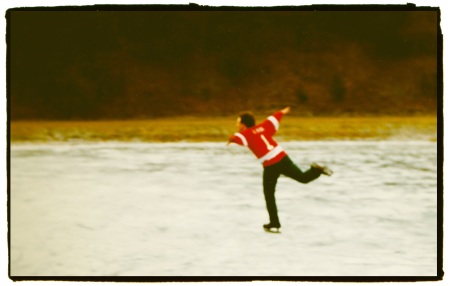


 Everywhere it snows, kids love winter. The first snow of the year is always the most exciting ─especially if you live in a place like the south-west coast of British Columbia, where snow is not guaranteed. When my boyfriend and I moved from Vancouver Island to Toronto to go to university, we were looking forward to escaping the cool, rainy winds of Victoria and experiencing a real Canadian winter of sunshine sparkling on snow and ice hockey on frozen ponds. We packed all our essential possessions in two large hockey bags (including two pairs of skates and a toaster oven). The morning we left, we discovered that our friends had graffitied a sarcastic message on the road in front of my boyfriend’s house: Craig loves Harold Ballard (Harold Ballard was the coach of the Toronto Maple Leafs hockey team at that time, and my boyfriend was not a Leaf’s fan). [Note: scrawled on the road in front of my parents' house were the words There is no pie in Toronto, but that's another story.]
Everywhere it snows, kids love winter. The first snow of the year is always the most exciting ─especially if you live in a place like the south-west coast of British Columbia, where snow is not guaranteed. When my boyfriend and I moved from Vancouver Island to Toronto to go to university, we were looking forward to escaping the cool, rainy winds of Victoria and experiencing a real Canadian winter of sunshine sparkling on snow and ice hockey on frozen ponds. We packed all our essential possessions in two large hockey bags (including two pairs of skates and a toaster oven). The morning we left, we discovered that our friends had graffitied a sarcastic message on the road in front of my boyfriend’s house: Craig loves Harold Ballard (Harold Ballard was the coach of the Toronto Maple Leafs hockey team at that time, and my boyfriend was not a Leaf’s fan). [Note: scrawled on the road in front of my parents' house were the words There is no pie in Toronto, but that's another story.]
Our first winter in Toronto did not start the way we expected. We discovered very quickly that the York University campus, where we were living, had the apt nickname, “Siberia,” and that we had exchanged the damp but relatively gentle winds of Victoria for the bone-chilling, driving sub-zero blast of what we were beginning to think of as a flat urban wasteland. Did things improve? Did we finally get that beautiful Ontario snow we were expecting? Well, you’ll have to read my story in the new collection, Chicken Soup for the Soul: O Canada The Wonders of Winter: 101 Stories about Bad Weather, Good Times, and Great Sports.
But seriously, Craig and I ended up having many wonderful winter experiences over our four years of living in Ontario (including snow-shoeing over pristine snow north of the city, seeing my first Snowy Owl and Snow Buntings on an outdoor education field trip, and gazing down at the frozen Niagara Falls as we crossed the bridge to the US to watch a hockey game in Buffalo). By our second winter, we had a car, and two of our good friends, Mark and Donna, had moved from the westcoast to Hamilton (an hour’s drive from Toronto), and on weekends we explored a lot of the countryside together. Craig and Mark were on a constant quest to find the best pond on which to play ice hockey. In warm weather, they scouted for accessible ponds with potential. When the temperature started to cool, they monitored the thickening ice. The moment the ice could hold their weight, they were out skating and passing a puck around (long before locals were ready to brave the ice). Donna and I skated too, but we never lasted as long as Craig and Mark.
When I saw the call for submissions to a Canadian winter themed Chicken Soup for the Soul, I knew I had to write something about our Ontario experience and the siren call of frozen ice. But which of our many winter memories should I pick? Should I write about the Christmas day we tested the ice on a pond in the middle of a deserted conservation area? Or the night we skated on an old outdoor rink ─with boards around the outside and lights overhead, canned music, and a warm-up hut with a wood stove? Or should I write about the time we were house and dog-sitting on a farm north of the city, and we skated on the farm pond as the two big dogs slipped and skidded around us? No. I decided to start at the beginning ─with the first winter and the first pond.



This little “breakfast-time” story I wrote for Smuckers Jam is available right now in the PB & J aisle of grocery stores across Canada (though finding it is a bit hit and miss).
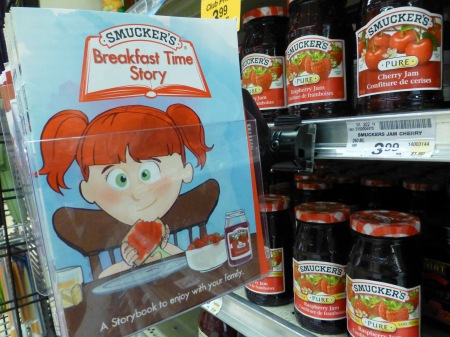
Here’s a little look inside:
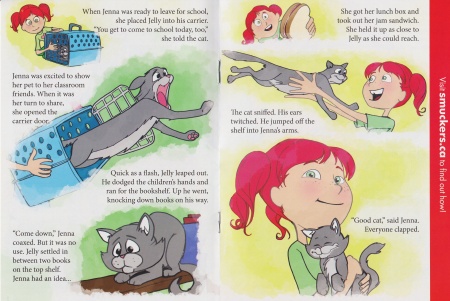
You can read or download the whole story here. The story is part of a summer campaign to encourage parents to read with their children (and buy Smuckers jam). There is also a contest with a story written by children’s author Ted Staunton as the prize. Find out more here (contest ends Aug 6, 2013). It’s a bit confusing, because it sounds like the prize is a personalized version of my story and that Ted Staunton wrote it (my name isn’t mentioned, and I knew it wouldn’t be when I wrote the story for them), but the prize (from what I understand) is a new story written by Ted, and the winning child and his/her family get included in the story.
Anyway, I had fun writing the story, and I’m happy to be part of something that encourages parents to read with their children (and I like jam).


This little “breakfast-time” story I wrote for Smuckers Jam is available right now in the PB & J aisle of grocery stores across Canada (though finding it is a bit hit and miss).

Here’s a little look inside:

You can read or download the whole story here. The story is part of a summer campaign to encourage parents to read with their children (and buy Smuckers jam). There is also a contest with a story written by children’s author Ted Staunton as the prize. Find out more here (contest ends Aug 6, 2013). It’s a bit confusing, because it sounds like the prize is a personalized version of my story and that Ted Staunton wrote it (my name isn’t mentioned, and I knew it wouldn’t be when I wrote the story for them), but the prize (from what I understand) is a new story written by Ted, and the winning child and his/her family get included in the story.
Anyway, I had fun writing the story, and I’m happy to be part of something that encourages parents to read with their children (and I like jam).


Interested in haiku poetry or how to use bamboo in your garden? This Saturday I’ll be joining other poets from the Vancouver Haiku Group at Vancouver’s Dr. Sun Yat Sen Classical Chinese Garden for a celebration of bamboo. Angela Naccarato, poet and Intuitive Consultant, will lead haiku workshops (open to anyone visiting the garden, with three workshop times between 1-3pm), and I will be sharing some of my photographs of “bamboo in Basho’s footsteps” (from my last visit to Japan).
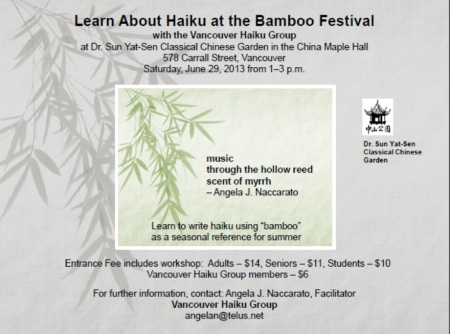
A haiku I wrote on my last visit to the garden:
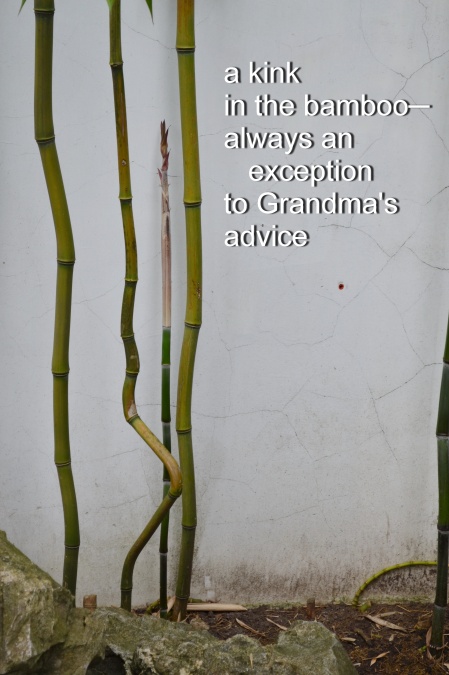


Interested in haiku poetry or how to use bamboo in your garden? This Saturday I’ll be joining other poets from the Vancouver Haiku Group at Vancouver’s Dr. Sun Yat Sen Classical Chinese Garden for a celebration of bamboo. Angela Naccarato, poet and Intuitive Consultant, will lead haiku workshops (open to anyone visiting the garden, with three workshop times between 1-3pm), and I will be sharing some of my photographs of “bamboo in Basho’s footsteps” (from my last visit to Japan).
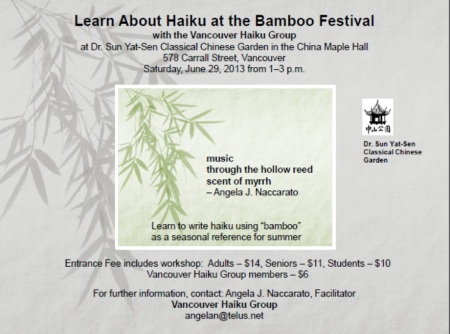
A haiku I wrote on my last visit to the garden:
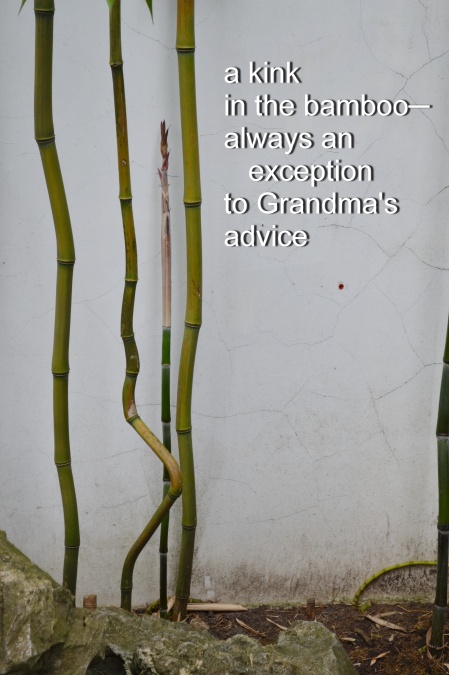


If haiku expresses a “now moment,” can haiku be written about the past? I’m immersing myself in early Vancouver history today to see if some haiku emerge, and I’ll be sharing the resulting “historical haiku” Thursday evening at Chapters bookstore in downtown Vancouver as part of a larger celebration of poetry and music with the Vancouver Haiku Group. Everyone is welcome! (May 23, 7-9:30 pm, Robson St. Chapters store)



If haiku expresses a “now moment,” can haiku be written about the past? I’m immersing myself in early Vancouver history today to see if some haiku emerge, and I’ll be sharing the resulting “historical haiku” Thursday evening at Chapters bookstore in downtown Vancouver as part of a larger celebration of poetry and music with the Vancouver Haiku Group. Everyone is welcome! (May 23, 7-9:30 pm, Robson St. Chapters store)

Needs some work, but here’s an example of what I’m working on:

(Main & 7th Ave about 1899 – I don’t remember where I got the photo from, so I hope I can be forgiven for not giving credit. It is probably from the Vancouver Archives, and I believe most of their old photos are in the public domain.)
Added after the event (in this photo James Mullin’s Asian flute accompanies Kozue Uzawa’s tanka reading):
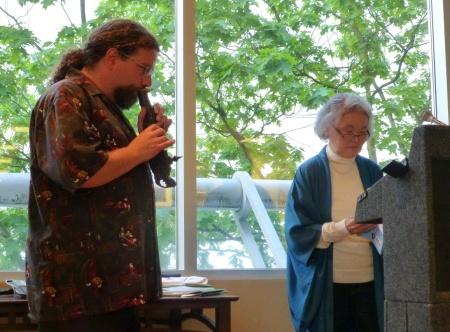
The event was led by Angela J. Naccarato, founder and facilitator of the Vancouver Haiku Group, who read some of her own haiku and free verse. Other poets included Marianne Dupre, Rosemary Carter, Brenda Larsen, Vicki McCullough, Liam Blackstock, Ashok Bhargava, Alegria Imperial, Donna Farley, Kozue Uzawa, James Mullin, and myself, taking the audience on a journey that evoked colours, sounds, and emotions from childhood memories in India to a monsoon in China to swimming with turtles in Barbados to Vancouver’s past to cherry blossoms in Vancouver’s present.

(Here, Liam Blackstock entertains the audience with charismatic readings/performance of his free verse poetry)


Some of my haiku are being featured this week on Daily Haiku, starting with this one posted today:
yellow smudged moon—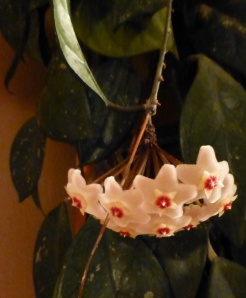
scent of hoya flower
in the empty room
The timing is perfect, as my hoya plant is now in bloom (and, as usual, I was alerted by the scent when I was up alone in the middle of the night). When I was a kid, my parents had a hoya plant for years before it finally blossomed. My mom thought my dad had tied some plastic flowers to the plant to play a joke on her.
This Daily Haiku cycle started April 7 with the haiku of invited poet LeRoy Gorman. Seven different poets are featured in rotation, until September (2013). Here’s a short haiku by Jim Kacian posted April 15, which suggests a whole story in a single line (and reawakens some vivid summer memories):
summer night she smells faintly of fire


Some of my haiku are being featured this week on Daily Haiku, starting with this one posted today:
yellow smudged moon—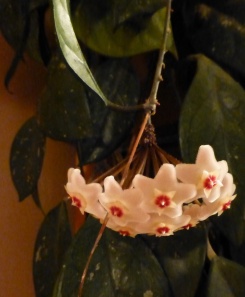
scent of hoya flower
in the empty room
The timing is perfect, as my hoya plant is now in bloom (and, as usual, I was alerted by the scent when I was up alone in the middle of the night). When I was a kid, my parents had a hoya plant for years before it finally blossomed. My mom thought my dad had tied some plastic flowers to the plant to play a joke on her.
This Daily Haiku cycle started April 7 with the haiku of invited poet LeRoy Gorman. Seven different poets are featured in rotation, until September (2013). Here’s a short haiku by Jim Kacian posted April 15, which suggests a whole story in a single line (and reawakens some vivid summer memories):
summer night she smells faintly of fire


What is haiku? Many people think it is simply a short three-line poem of 5-7-5 syllables. But please forget this definition! It leads to things like:
that song was poppin
hari ini tdr gk ya?
Sorting the bedroom
-Haiku Robot
or
Haikus are easy
but sometimes they don’t make sense
Refrigerator
-anonymous
What is a haiku, really? Haiku is a very short form of poetry (originally Japanese) that aims to capture the essence of something. It uses simple, direct language to point to a thing or moment (usually in nature), while at the same time implying something more. Traditional haiku contains three main elements:
- a kigo (seasonal reference)
- a kireji (cutting word, symbol, or pause, that divides the haiku into two juxtaposed parts)
- 17 on (17 Japanese sound units), with the poem usually broken into three phrases of 5-7-5 on (written in Japanese as one or two vertical lines)
Today, haiku are written all over the world in many different languages, including English (the word “haiku” is both singular and plural).
The 17 Japanese on sounds do not actually correspond to English syllables (for example, the word “on” itself, which English-speakers would view as a single syllable, comprises two on). Translating a Japanese haiku into 17 English syllables actually makes the haiku longer than it was meant to be. For example, a famous haiku by the 17th century Japanese poet Basho was originally written using 17 on, but it is translated:
old pond…
a frog leaps in
water’s sound
To translate it into 17 English syllables would make it too cumbersome, moving away from the original intent of the poem. Here’s an example (from the Wikipedia haiku page):
at the age old pond
a frog leaps into water
a deep resonance
It’s the simplicity and directness of the first translation (and the original haiku) that catches the reader’s attention and leaves the reader room to see the moment for him or herself. In fact, it’s haiku’s simplicity ─its ability to focus the reader in on a precise, concrete “a-ha” moment─ that makes it so appealing to many haiku-lovers. Simplicity keeps the moment fresh. Any added decoration, metaphor or explanation entangles the reader; gives you so much that there is nothing to stop and think about. The simple wording engages your imagination. You pause and hear the sound of the water as the frog’s body breaks the surface. But the simply written haiku can also imply emotion and allude to deeper meaning. The “old pond,” for example, can be read as a reference to Basho, himself, an old poet still moved by the world around him.
So, the idea that English haiku should be written in 17 syllables is not actually correct, and throwing a bunch of words together into three lines of 5-7-5 syllables (even if they are poetically written, rather than generated by a robot) does not make those lines a haiku. To be a real haiku, a poem has to have some or all of the elements mentioned above (seasonal reference, simplicity, and also a juxtaposition or a space between images that suggests something deeper). In other words, “That song was poppin” is not a haiku.
Here are a few haiku I’ve come across recently that I really like (my favorite haiku are always changing):
evening walk
the faded leash
I can’t throw out
-John Soules
abandoned farm
still there, the scents
in the barn
-George Swede
graveside
forming one shadow
with my sister
-Tom Painting
solo hike─
slowly catching up
with myself
-Annette Makino
You’ll notice that none of them have 5-7-5 syllables. But yes, all of them are haiku.
I hope this post doesn’t sound like an anti-5-7-5 rant. Like many people, I grew up thinking English haiku had to be written as three lines of 5-7-5 syllables (you’ll find many haiku written this way in my earlier blog posts), and I wasn’t really conscious of the other elements of good haiku, other than the seasonal reference. I wrote and read haiku intuitively, I guess (with mixed results). I still write this way, but I’ve also been making an effort to think more about haiku, how it works, and what makes a good haiku (which leads to more re-writing), and I’ve come across an awful lot of writing that calls itself haiku, but is not. This pseudo-haiku is sometimes interesting writing forced to fit the 5-7-5 format (often with the first sentence ending in the middle of the second line), or even good poetry with intriguing metaphors, but it’s not haiku. The main point I want to make here is that haiku is about more than syllable count (I’m talking to you, Haiku Robot, children’s book publishers of stories written in so-called “haiku” format, companies that hold “haiku” slogan contests to advertise new products, and anyone who leaves comments on haiku blogs complaining that the haiku is not real haiku because the syllable count isn’t right).
Okay, maybe this is an anti-5-7-5 rant.
Anyway, if you want to learn more about haiku, here are some good websites and blog posts to check out:
Haiku on Wikipedia (good explanation of haiku and the issues around syllable count)
Graceguts, the website of haiku poet, Michael Dylan Welch (contains examples of haiku, articles, and links to other resources)
Haiku checklist (helpful for thinking about and revising your own haiku)
Essential elements of haiku
Haiku journey of poet Ferris Gilli (many good insights into how to write haiku)
How to write bad haiku (a fun post that looks at what makes a haiku “bad” or “good”)
Why No 5-7-5
Kireji and kigo (cutting word & seasonal reference)
More on juxtaposition and seasonal references


What is haiku? Many people think it is simply a short three-line poem of 5-7-5 syllables. But please forget this definition! It leads to things like:
that song was poppin
hari ini tdr gk ya?
Sorting the bedroom
-Haiku Robot
or
Haikus are easy
but sometimes they don’t make sense
Refrigerator
-anonymous
What is a haiku, really? Haiku is a very short form of poetry (originally Japanese) that aims to capture the essence of something. It uses simple, direct language to point to a thing or moment (usually in nature), while at the same time implying something more. Traditional haiku contains three main elements:
- a kigo (seasonal reference)
- a kireji (cutting word, symbol, or pause, that divides the haiku into two juxtaposed parts)
- 17 on (17 Japanese sound units), with the poem usually broken into three phrases of 5-7-5 on (written in Japanese as one or two vertical lines)
Today, haiku are written all over the world in many different languages, including English (the word “haiku” is both singular and plural).
The 17 Japanese on sounds do not actually correspond to English syllables (for example, the word “on” itself, which English-speakers would view as a single syllable, comprises two on). Translating a Japanese haiku into 17 English syllables actually makes the haiku longer than it was meant to be. For example, a famous haiku by the 17th century Japanese poet Basho was originally written using 17 on, but it is translated:
old pond…
a frog leaps in
water’s sound
To translate it into 17 English syllables would make it too cumbersome, moving away from the original intent of the poem. Here’s an example (from the Wikipedia haiku page):
at the age old pond
a frog leaps into water
a deep resonance
It’s the simplicity and directness of the first translation (and the original haiku) that catches the reader’s attention and leaves the reader room to see the moment for him or herself. In fact, it’s haiku’s simplicity ─its ability to focus the reader in on a precise, concrete “a-ha” moment─ that makes it so appealing to many haiku-lovers. Simplicity keeps the moment fresh. Any added decoration, metaphor or explanation entangles the reader; gives you so much that there is nothing to stop and think about. The simple wording engages your imagination. You pause and hear the sound of the water as the frog’s body breaks the surface. But the simply written haiku can also imply emotion and allude to deeper meaning. The “old pond,” for example, can be read as a reference to Basho, himself, an old poet still moved by the world around him.
So, the idea that English haiku should be written in 17 syllables is not actually correct, and throwing a bunch of words together into three lines of 5-7-5 syllables (even if they are poetically written, rather than generated by a robot) does not make those lines a haiku. To be a real haiku, a poem has to have some or all of the elements mentioned above (seasonal reference, simplicity, and also a juxtaposition or a space between images that suggests something deeper). In other words, “That song was poppin” is not a haiku.
Here are a few haiku I’ve come across recently that I really like (my favorite haiku are always changing):
evening walk
the faded leash
I can’t throw out
-John Soules
abandoned farm
still there, the scents
in the barn
-George Swede
graveside
forming one shadow
with my sister
-Tom Painting
solo hike─
slowly catching up
with myself
-Annette Makino
You’ll notice that none of them have 5-7-5 syllables. But yes, all of them are haiku.
I hope this post doesn’t sound like an anti-5-7-5 rant. Like many people, I grew up thinking English haiku had to be written as three lines of 5-7-5 syllables (you’ll find many haiku written this way in my earlier blog posts), and I wasn’t really conscious of the other elements of good haiku, other than the seasonal reference. I wrote and read haiku intuitively, I guess (with mixed results). I still write this way, but I’ve also been making an effort to think more about haiku, how it works, and what makes a good haiku (which leads to more re-writing), and I’ve come across an awful lot of writing that calls itself haiku, but is not. This pseudo-haiku is sometimes interesting writing forced to fit the 5-7-5 format (often with the first sentence ending in the middle of the second line), or even good poetry with intriguing metaphors, but it’s not haiku. The main point I want to make here is that haiku is about more than syllable count (I’m talking to you, Haiku Robot, children’s book publishers of stories written in so-called “haiku” format, companies that hold “haiku” slogan contests to advertise new products, and anyone who leaves comments on haiku blogs complaining that the haiku is not real haiku because the syllable count isn’t right).
Okay, maybe this is an anti-5-7-5 rant.
Anyway, if you want to learn more about haiku, here are some good websites and blog posts to check out:
Haiku on Wikipedia (good explanation of haiku and the issues around syllable count)
Graceguts, the website of haiku poet, Michael Dylan Welch (contains examples of haiku, articles, and links to other resources)
Haiku checklist (helpful for thinking about and revising your own haiku)
Essential elements of haiku
Haiku journey of poet Ferris Gilli (many good insights into how to write haiku)
How to write bad haiku (a fun post that looks at what makes a haiku “bad” or “good”)
Why No 5-7-5
Kireji and kigo (cutting word & seasonal reference)
More on juxtaposition and seasonal references


It’s been a grey rainy week here in Vancouver, but downtown today, I had an unexpected glimpse of cherry blossoms and sunshine ─appropriate for the start of National Haiku Writing Month (February, the shortest month for the shortest poetic form).
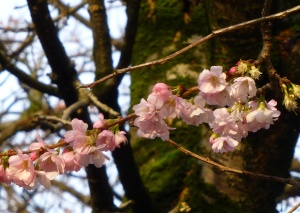
early blossoms─
a new spring
in my step
Click here for more info on National Haiku Writing Month (NaHaiWriMo).


It’s been a grey rainy week here in Vancouver, but downtown today, I had an unexpected glimpse of cherry blossoms and sunshine ─appropriate for the start of National Haiku Writing Month (February, the shortest month for the shortest poetic form).

early blossoms─
a new spring
in my step
Click here for more info on National Haiku Writing Month (NaHaiWriMo).



gray winter day
the barista offers me
a flower



gray winter day
the barista offers me
a flower


 I thought I’d share a glimpse into the wonderful writing retreat I experienced last month at Spark Box Studio near Picton Ontario (with funding gratefully received from the Canada Council!). A whole week without distractions, focusing on the craft of writing historical picture books! I was particularly interested in exploring the question, “How do I take a huge topic such as the War of 1812 and hone in on a small story suitable for children?”
I thought I’d share a glimpse into the wonderful writing retreat I experienced last month at Spark Box Studio near Picton Ontario (with funding gratefully received from the Canada Council!). A whole week without distractions, focusing on the craft of writing historical picture books! I was particularly interested in exploring the question, “How do I take a huge topic such as the War of 1812 and hone in on a small story suitable for children?”
To help me get on the right footing for my retreat, I stopped in Toronto beforehand to meet with children’s  book author Monica Kulling, for a thoughtful and inspiring discussion about writing historical stories for children. Her latest book, Lumpito and the Painter from Spain, about a little dog who touched the life of Pablo Picasso, was hot off the press, and provided a great example (I love the dog, illustrated by Dean Griffiths).
book author Monica Kulling, for a thoughtful and inspiring discussion about writing historical stories for children. Her latest book, Lumpito and the Painter from Spain, about a little dog who touched the life of Pablo Picasso, was hot off the press, and provided a great example (I love the dog, illustrated by Dean Griffiths).
Next, I took a side trip to soak up some War of 1812 history and watch the reenactment of the Battle of Queenston Heights near Niagara Falls. The  boom of cannons, smell of smoke, calls of the soldiers, costumes of the military and civilian reenactors, and the cool, damp fall day helped to cast a spell that opened a window into the past.
boom of cannons, smell of smoke, calls of the soldiers, costumes of the military and civilian reenactors, and the cool, damp fall day helped to cast a spell that opened a window into the past.
At Spark Box Studio, I started each day with a solitary walk between farmers’ fields. The empty fields, subdued colours, and the whispers and rustles of leaves and grasses that followed me as I walked, made it easy to imagine a young girl two hundred years in the past, standing on the edge of a field, hearing 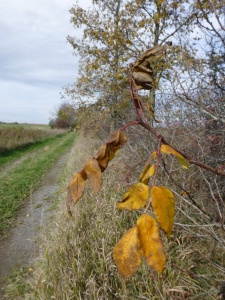 the distant boom of cannon and cracks of musket fire. I felt like I was walking with one foot in the present and one in the past as I wrote these haiku:
the distant boom of cannon and cracks of musket fire. I felt like I was walking with one foot in the present and one in the past as I wrote these haiku:
autumn wind─
on the lonely path
many voices
&
whispering grasses─
the words always
out of reach
While it was great to have so much time to myself to think and write, talking with the creative hosts and other guests at Spark Box Studio was also enriching. And, despite that last haiku, the words weren’t out of reach. I finished the first draft of a picture book story and concluded the retreat feeling buoyed in spirit, recharged and reinspired to continue writing…



View Next 25 Posts










































































Congratulations, Jacqui!
Thanks, Dominique!
LooKs great! I like the different levels of the present-day actors interpreting the real events of more than 200 years ago.
Thanks, Julie :)